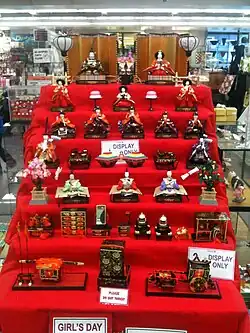雛祭り
Japanese

雛祭り (Hina matsuri): a Hina matsuri store display featuring all 7 tiers of the dolls' imperial court.
| Kanji in this term | |
|---|---|
| 雛 | 祭 |
| ひな Jinmeiyō |
まつ Grade: 3 |
| kun’yomi | |
Proper noun
雛祭り • (Hina Matsuri)
- The Japanese festival of Hina matsuri, held on 3 March.
- Also known as "Girls' Day" or the "Doll Festival", wherein most families with girls pray for their young girls' growth and future happiness. Celebrated with displays of dolls representing the imperial court, before which are placed offerings such as diamond-shaped mochi (doughy rice cakes), white sake, and peach blossoms. Also called 桃の節句 (Momo no Sekku, “the Peach Festival”) as Hina matsuri occurs during the peach blossom season on the old lunar calendar.
See also
Further reading
 日本の祭り (List of festivals in Japan) on the Japanese Wikipedia.Wikipedia ja
日本の祭り (List of festivals in Japan) on the Japanese Wikipedia.Wikipedia ja List of festivals in Japan on Wikipedia.Wikipedia
List of festivals in Japan on Wikipedia.Wikipedia
References
- NHK Broadcasting Culture Research Institute, editor (1998), NHK日本語発音アクセント辞典 [NHK Japanese Pronunciation Accent Dictionary] (in Japanese), Tōkyō: NHK Publishing, →ISBN
- Matsumura, Akira, editor (2006), 大辞林 [Daijirin] (in Japanese), Third edition, Tōkyō: Sanseidō, →ISBN
This article is issued from Wiktionary. The text is licensed under Creative Commons - Attribution - Sharealike. Additional terms may apply for the media files.